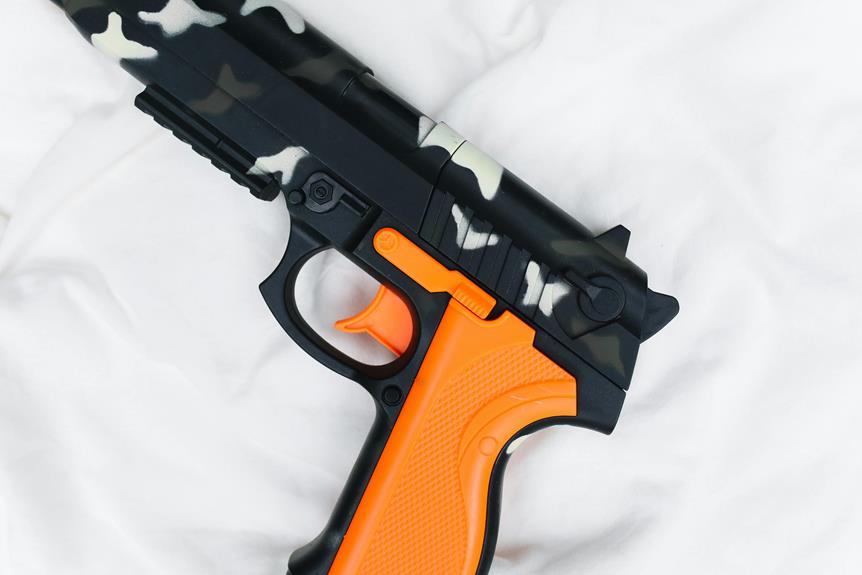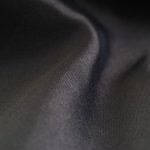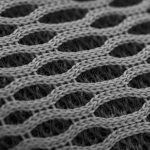When you're tackling DIY fabric projects, using Scotchgard can significantly enhance the durability and longevity of your materials. You'll want to start by selecting the right fabric and ensuring it's clean and dry. It's crucial to conduct a spot test to avoid any unpleasant surprises later. Once you know your fabric is compatible, you can apply Scotchgard effectively. But there are important steps and tips to keep in mind that can make all the difference in your project's outcome. Understanding these details will set you up for success. What's next?
Table of Contents
Key Takeaways
- Choose durable fabrics like canvas or polyester, and clean them thoroughly before applying Scotchgard to ensure effectiveness.
- Test compatibility by spraying a small, inconspicuous area and checking for discoloration before full application.
- Apply Scotchgard in a well-ventilated area, using light, even coats, and allow for adequate drying and curing times.
- Maintain treated fabric by spot cleaning spills immediately and reapplying Scotchgard every 6-12 months.
Understanding Scotchgard Products
Scotchgard products are designed to protect your fabrics from stains and spills, making them essential for any DIY fabric project.
When you choose Scotchgard, you're opting for a reliable solution that helps keep your fabrics looking fresh and new. The key to its effectiveness lies in its unique formula, which creates a barrier on the surface of the material. This barrier repels liquids and prevents dirt from settling in, giving you peace of mind during your crafting.
There are various types of Scotchgard products available, including fabric protectors, upholstery cleaners, and more. Depending on your project, you might find a specific product that caters to your needs, whether you're working with upholstery or clothing.
Before applying Scotchgard, ensure you read the instructions carefully. You'll want to know how long the product takes to dry and how many coats are recommended for optimal protection.
Using Scotchgard not only helps you maintain the integrity of your fabrics but also saves you time and effort in cleaning. With a little preparation and the right application, you can create beautiful, lasting fabric projects that stand up to everyday wear and tear.
Preparing Your Fabric
Before applying Scotchgard, you need to choose the right fabric for your project.
Make sure it's clean and thoroughly dry to ensure proper adhesion.
Taking these steps will help you get the best results from your Scotchgard treatment.
Choose the Right Fabric
Selecting the right fabric is crucial for ensuring your DIY projects effectively benefit from Scotchgard's protective qualities. When you choose the appropriate material, you'll enhance the durability and longevity of your project, making it more resistant to stains and spills.
Here are some key factors to consider when selecting your fabric:
- Type of Fabric: Look for fabrics like canvas, nylon, or polyester, as they tend to hold up well against water and stains.
- Weave: Fabrics with tighter weaves provide better protection, as they resist liquid penetration more effectively than loose weaves.
- Color and Pattern: Consider darker colors or busy patterns to help mask any potential stains. Lighter fabrics may require more frequent cleaning.
Clean and Dry Thoroughly
To ensure optimal protection, you need to clean and dry your fabric thoroughly before applying Scotchgard. Start by removing any dirt, dust, or stains. Use a vacuum for upholstery or a lint roller for smaller items. If your fabric is machine washable, follow the care instructions and wash it in the appropriate cycle. For stains, treat them with a suitable fabric cleaner, making sure to test on a small, inconspicuous area first.
After washing, check that the fabric is free from any detergent residue. Rinse it thoroughly if necessary. If your fabric can't be washed, consider spot cleaning with a gentle solution and a soft cloth. Once cleaned, it's crucial to dry your fabric completely. If you've washed it, air dry or tumble dry according to the care label. Make sure it's completely dry to prevent any mold or mildew, which can affect the Scotchgard application.
Before applying Scotchgard, ensure the area is well-ventilated. Lay your fabric flat or hang it up, keeping it stable. Now, you're ready to protect your fabric effectively with Scotchgard!
Testing for Compatibility
Before you apply Scotchgard, it's crucial to check if your fabric is compatible.
Different materials react differently, so you'll want to be aware of the fabric type you're working with.
A simple spot test can save you from potential mishaps, ensuring your project stays safe and intact.
Fabric Type Considerations
Testing a small, hidden area of your fabric for compatibility with Scotchgard can save you from potential damage later on. Different fabrics react uniquely to the spray, so it's crucial to ensure your material can handle it.
Here are some common fabric types to consider:
- Cotton: Generally safe, but always test first, especially with dyed fabrics.
- Polyester: Usually compatible, but some blends may not react well.
- Silk: Highly sensitive; avoid using Scotchgard unless you're sure of its compatibility.
Take your time to assess how your fabric responds. If you notice any discoloration or change in texture after the test, don't proceed with applying Scotchgard.
It's better to be cautious than to ruin your fabric project. By checking compatibility, you'll protect your investment and ensure that your DIY projects turn out beautifully.
Spot Test Method
A simple spot test can help you determine if your fabric is compatible with Scotchgard, ensuring you avoid any unwanted damage.
To start, select an inconspicuous area of your fabric—like a seam or the underside. Shake the Scotchgard canister well before use, then hold it about 6-8 inches away from the fabric. Spray a small amount on the chosen spot and allow it to dry completely.
After the area dries, check for any discoloration or change in texture. If the fabric looks and feels the same, you're good to go! However, if you notice any damage, like fading or stiffness, it's best to avoid using Scotchgard on that material.
Keep in mind that different fabrics respond differently, so don't skip this essential step. Once you confirm compatibility, you can confidently apply Scotchgard to your entire project.
Always remember to follow the manufacturer's instructions for the best results. By taking this precaution, you'll ensure your DIY fabric projects enjoy the protection they need without compromising their quality.
Happy crafting!
Applying Scotchgard Properly
To apply Scotchgard properly, make sure you clean the fabric thoroughly and let it dry completely before starting the treatment. This step is crucial for ensuring that the Scotchgard adheres effectively and provides the best protection.
Once your fabric is clean and dry, follow these simple steps:
- Choose a well-ventilated area: Make sure you're in a space with good airflow to avoid inhaling any fumes.
- Shake the can well: This helps to mix the contents and ensures an even spray.
- Hold the can about 6-12 inches away: Maintaining this distance allows for a fine mist and better coverage.
After you've applied Scotchgard, allow it to sit for a moment before you consider moving on to the next stage.
Following these guidelines will help you achieve a successful application, ensuring your fabric remains protected against spills and stains.
Drying and Curing Time
Once you've applied Scotchgard, allowing adequate drying and curing time is vital for achieving optimal protection on your fabric. Generally, you'll want to let the fabric dry for at least two hours before handling it. This initial drying phase allows the Scotchgard to bond with the fibers effectively.
After the first two hours, it's best to wait an additional 24 hours for the product to fully cure. During this curing period, avoid exposing the fabric to moisture or heavy use. This ensures the protective layer forms correctly and gives you the best defense against spills and stains.
You can speed up the drying process by placing the fabric in a well-ventilated area or using a fan. Just make sure not to apply any heat sources like hair dryers, as they can interfere with the curing process.
Check the fabric periodically to make sure it feels dry to the touch. Once the full curing time has passed, you can confidently use your newly treated fabric, knowing it's properly protected. Remember, patience pays off when it comes to ensuring your DIY projects stand the test of time!
Maintenance Tips for Treated Fabric
Regularly checking and cleaning your treated fabric helps maintain its protective qualities and longevity. By following a few simple maintenance tips, you can keep your fabric looking great while ensuring the Scotchgard treatment remains effective.
- Spot Clean: Act quickly to clean any spills or stains. Use a mild detergent and a soft cloth. Avoid harsh chemicals that might degrade the treatment.
- Gentle Washing: If your fabric is machine washable, use a gentle cycle with cold water. This helps preserve both the fabric and the Scotchgard treatment.
- Air Dry: After washing, air dry your fabric whenever possible. High heat from dryers can weaken the protective layer, so opt for hanging it up instead.
Troubleshooting Common Issues
When you notice issues with your Scotchgard-treated fabric, addressing them promptly can help restore its protective qualities.
One common problem is water not beading on the surface. This usually means the treatment has worn off. To fix this, clean the fabric thoroughly and reapply Scotchgard according to the instructions. Make sure to work in a well-ventilated area to avoid inhaling fumes.
Another issue you might encounter is staining. If spills soak into the fabric, act fast. Blot the stain with a clean cloth instead of rubbing it, which can spread the stain. After blotting, use a mild detergent solution to clean the area, then rinse with water.
Once the fabric is dry, consider reapplying Scotchgard to restore its protective barrier.
Frequently Asked Questions
Can I Use Scotchgard on Leather or Suede Fabrics?
You can't use Scotchgard on leather or suede because it can damage their texture and appearance. Instead, look for products specifically designed for leather and suede to protect them without compromising their quality.
How Long Does Scotchgard Last After Application?
Scotchgard typically lasts about two to three months after application, depending on exposure to elements and wear. To maintain its effectiveness, you should reapply it periodically, especially on high-traffic areas or outdoor fabrics.
Is Scotchgard Safe for Children and Pets?
You'll be relieved to know that Scotchgard, when used correctly and fully dried, is generally safe for children and pets. Just ensure to ventilate the area during application and keep them away until it dries.
Can I Wash Fabric Treated With Scotchgard?
Yes, you can wash fabric treated with Scotchgard. Just remember to follow the care instructions on the label. It's best to use a gentle cycle and avoid harsh detergents to maintain the fabric's protective qualities.
Does Scotchgard Change the Color of My Fabric?
Scotchgard typically doesn't change your fabric's color, but it's always best to test a small, inconspicuous area first. This way, you can ensure the treatment doesn't alter the shade or appearance of your fabric.
- How Does Ring Spun Cotton Affect Garment Fit and Shape Retention? - August 13, 2024
- What Are the Challenges in Producing Ring Spun Cotton? - August 13, 2024
- Is Ring Spun Cotton Suitable for Plus-Size Clothing? - August 13, 2024







